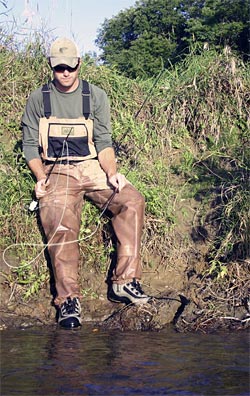“Can I Repair a Fly Rod in the Field?”
Have a question you want answered? Email it to us at [email protected].
Question: Pretty much every rod comes with a guarantee, but if you break a rod while on a float trip or something, is there any way to repair it—even temporarily—in the field so you can keep on using it?
Alex G., West Lafayette, IN
 Answer: Before I started guiding in Alaska, I had never broken a rod in my life. That first summer, I broke three: two on tail-hooked sockeyes and one on a willow branch. After I busted a 9-weight at the first ferrule (totally my fault, by the way), I called the customer service number at L.L. Bean from the radio phone in the lodge and explained my situation. The agent’s reply when she heard my story is still my favorite customer-service response of all time. “We’d better FedEx you another one!” she said enthusiastically.
Answer: Before I started guiding in Alaska, I had never broken a rod in my life. That first summer, I broke three: two on tail-hooked sockeyes and one on a willow branch. After I busted a 9-weight at the first ferrule (totally my fault, by the way), I called the customer service number at L.L. Bean from the radio phone in the lodge and explained my situation. The agent’s reply when she heard my story is still my favorite customer-service response of all time. “We’d better FedEx you another one!” she said enthusiastically.
While that did give me a warm, fuzzy feeling inside, it still meant that I wouldn’t have a 9-weight for about three days. I got a better angling outcome when the tip of my 6-weight, which was hanging out the back of a johnboat, snagged a willow branch. The top two inches had broken off cleanly, but the line had kept the broken piece from falling in the water. My fellow guide, Gordon Gracey, saw my stricken look and said, “No problem.” He broke out a lighter and held it under the tip-top guide on the broken piece until the glue melted enough that he could separate the guide from the graphite. Then he jammed the tip-top onto the tip of the remaining rod, lined it up with the other guides, and held it there for a minute. When he was confident it was reasonably stuck, he dipped it in the cool water to reset the glue.
“Voila!” he announced, handing the rod back to me. I fished with it that way for the rest of the summer.
To ask what other in-the-field repairs were possible, I called Jim Logan at the Orvis rod shop, where they see thousands of broken rods every year. When I asked him about field repairs, he laughed.
“The tip-top trick is really the only repair that actually works well,” he said, and he recommends that you carry an extra tip-top and some glue any time you’re going on a long trip where you won’t have access to a fly shop. But if a rod breaks anywhere below the first 3 or 4 inches, you’re really out of luck, he says.
Logan says he’s heard of anglers creating the male end of a spigot ferrule out of a stick, but he doubts it would hold up to any real pressure. When I asked him if you could simply take out the broken piece of a 6-piece rod and just use five pieces, he hemmed and hawed a little.
“Your problem would be that the male ferrule would be too small, but you could build up its diameter with duct tape to create a snug fit.”
No doubt, the resulting rod would not cast as well as it had before, but such a repair might get you through the rest of the day. You’d be wise to check the ferrule quite often.
Smart anglers bring two rods whenever they can, and Logan says that, with a little jiggling and arranging, you can get two rods in almost any single-rod tube. All you have to do is put one butt-section in grip-down, and the other grip-up. You may have to offset the stripping guides, as well, to get all the pieces to fit. Then, if you are unlucky enough to break a rod, you’ve got a backup ready to go.
A Quick Tip-Top Fix
- Trim and clean the broken end of the rod where you plan to stick the tip-top. Get rid of any ragged pieces of graphite, and, if possible, file the break flat across the top.
- Hold a lighter or a candle under the base of the tip-top guide on the broken piece until you feel the guide start to loosen.
- Remove the tip-top from the broken piece.
- If you have any kind of glue, squirt it into the base of the tip-top and immediately stick it on the cleaned end of the rod.
- Quickly line up the tip-top with the other guides on the rod.
- Hold the tip-top in place until it no longer moves when you twist it.
- Put the rod tip and tip-top in slack water close to sure to set the glue.











